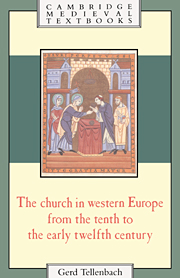Book contents
- Frontmatter
- Contents
- Translator's note
- Author's preface
- List of abbreviations
- 1 Western Christendom and its environment in the tenth and eleventh centuries
- 2 The church and its manifestations on earth
- 3 The material existence of the churches and the clergy
- 4 Religious life and thought
- 5 The beginnings of the revolution in church history
- 6 Gregory VII (1073–1085)
- 7 Continuing conflicts between established principles
- 8 Pope, church, and Christendom
- Epilogue
- Select bibliography
- Index
- Cambridge Medieval Textbooks
4 - Religious life and thought
Published online by Cambridge University Press: 05 June 2012
- Frontmatter
- Contents
- Translator's note
- Author's preface
- List of abbreviations
- 1 Western Christendom and its environment in the tenth and eleventh centuries
- 2 The church and its manifestations on earth
- 3 The material existence of the churches and the clergy
- 4 Religious life and thought
- 5 The beginnings of the revolution in church history
- 6 Gregory VII (1073–1085)
- 7 Continuing conflicts between established principles
- 8 Pope, church, and Christendom
- Epilogue
- Select bibliography
- Index
- Cambridge Medieval Textbooks
Summary
THE SENSE OF CLOSENESS BETWEEN THIS WORLD AND THE NEXT
It has become customary to speak of the faith or piety of the people or of the masses and to posit a distinction between this and the religious notions of the educated, in particular of the clergy and the lay élite. According to this view popular religiosity was suffused with archaic, numinous, pre- Christian elements, which had long been excluded from the church by the early councils and popes. As an example of this we need only mention the veneration of stones, trees, and waters, or the fear of witches and demons. Credulity in respect of the legends of the saints, of miracles, and of the effects of relics is also often taken to be a sign of ‘popular’ religion. More recently there has been a cautious reaction against this view, seen for example in the following quotation from Raoul Manselli (though he too is concerned with ‘popular religion’ in the middle ages): ‘it would in our opinion be a fundamental methodological error to conceive of popular religion as having been something quite different from learned religion’. It is indeed an error to separate popular religion or popular piety from a theoretically more or less enlightened religion. How could medieval religion have been differentiated according to social position or education? To suppose that it could is to project the ideas of the Enlightenment back into the middle ages.
- Type
- Chapter
- Information
- Publisher: Cambridge University PressPrint publication year: 1993



